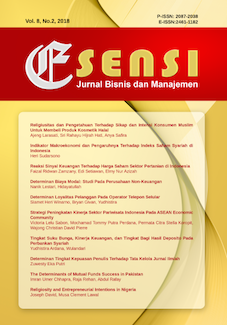The Determinants of Mutual Funds Success in Pakistan
DOI:
https://doi.org/10.15408/ess.v8i2.7431Keywords:
mutual funds, equity funds, net asset value, risk-adjusted returnAbstract
The prime goal of this research is to find out the determinants of mutual fund’s success in Pakistan. This study exploits the convenient sampling techniques and the data gathered from fund manager reports, annual reports, and from CDCPL. The sample size of this study relaxed to six Assets Management Companies (AMC)’s from 2013 to 2017. We applied a unit root test for finding the nature of data and check the variation of variable’s mutual performance by Hausman Technique. Moreover, we depicted the association between dependent and independent variables with the help of Constant Coefficient Model. It was concluded that risk-adjusted return, management structure, and expense ratio have a significant impact on the size of fund of selected AMC’S of Pakistan. However, the net asset value found to be negatively related with the size of the fund. This research will help investors, AMC’s and regulatory bodies to understand the dynamics of mutual funds in Pakistan.
References
Anwar, S. M. R., & Arif, T. M. H. (2016). Evaluation of Mutual Funds Performance in Bangladesh: Investors and Market Perspektive. Global Journal of Management and Business Research. Vol. 16 (9): 1-10.
Barber, B., & Odean, T. (2008). All That Glitters: The Effects of Attention and News on the Buying Bahavior of Individual and Institutional Investors. Review of Financial Studies. Vol. 21 (2): 785 – 818.
Bernstein, L. A., & John, J. W. (1998). Financial Statement Analysis: Theory, Application, and Interpretation, 6th edition. New York: Mc Graw-Hill.
Berk, J. B., & Van Binsbergen, J. H. (2015).Measuring Skill in The Mutual Fund Industry. Journal of Financial Economics. Vol. 118(1): 1-20.
Busse, J. A. (1999). Volatility Timing in Mutual Funds: Evidence from Daily Returns. Review of Financial Studies. Vol. 12 (5): 1009 – 1041.
Cao, C., Simin, T. T., & Wang, Y. (2013). Do Mutual Fund Managers’ Time Market Liquidity? Journal of Financial Markets. Vol. 16(2): 279-307.
Chen, J., Hong, H., Huang, M., & Kubik, J. D. (2004). Does Fund Erode Mutual Fund Perfoemance? The Role of Liquidity and Organization. American Economic Review. Vol. 94 (5): 1276-1302. doi: https://doi.org/ 10.1275/ 0002828043052277.
Cremers, M., & Petajisto, A. (2009). How Active Is Your Fund Manager? A New Measure That Predicts Performance. Review of Financial Studies. Vol. 22 (9): 3329-3365.
Dey, D. K., Chauhan, Y. K., & Chakraborti, R. (2015). Does Advertising Strategy Matter in Influencing Mutual Fund Purchase? Journal of Financial Services Marketing. Vol. 20(1): 23-33.
Engelberg, J. E., & Parsons, C. A. (2011). The Causal Impact of Media in Financial Markets. The Journal of Finance. Vol. 66 (1): 67 – 97.
Elton, E. J., Gruber, M. J., & Blake, C. R. (2012). Does Mutual Fund Size Matter? The Relationship Between Size and Performance. The Review of Asset Pricing Studies. Vol. 2(1): 31-55.
Fang, Lily, and Joel Peress (2009). Media Coverage and The Cross‐Section of Stock Returns. The Journal of Finance. Vol. 64(5): 2023-2052.
Ferreira, M. A., Keswani, A., Miguel, A. F., & Ramos, S. B. (2013). The Determinants of Mutual Fund Performance: A Cross-Country Study. Review of Finance. Vol. 17(2): 483-525.
Grinblat, M., & Titman, S. (1993). Performance Measurement without Benchmarks: An Examination of Mutual Fund Returns. The Journal of Business. Vol. 66 (1): 47-68.
Huang, J. (2015). Dynamic Liquidity Preferences of Mutual Funds. Second Singapore International Conference on Finance 2008. Available at SSRN: https://ssrn.com/abstract=967553 or http://dx.doi.org/10.2139/ssrn.967553
Huij, J., & Lansdorp, S. D. (2012). Mutual Fund Performance Persistence, Market Efficiency, and Breadth. Working Paper. Rotterdam: Erasmus University Rotterdam
Khorana, A., & Servaes, H. (1999). The Determinants of Mutual Fund Starts. The Review of Financial Studies. Vol. 12(5): 1043-1074.
Madhusudan, V. J. (1996). Marketing Strategies of Mutual Funds – Current Practices and Future Directions. Working Paper, UTI – IIMB Centre for Capital Markets Educations and Research, Bangalore.
Mannar, R. B., & Reddy, R. C. B. (2013). Analysis of Insight of Investors towards Mutual Funds. RIJBFA. Vol. 2 (2): 131-140.
Nathaphan, S., & Chunhachinda, P. (2012). Determinants of Growth for Thai Mutual Fund Industry. International Research Journal of Finance and Economics. Vol. 86: 120-131.
Nazir, M. S., & Nawaz, M. M. (2010).The Determinants of Mutual Fund Growth in Pakistan. International Research Journal of Finance and Economics. Vol. 54(10): 1051-1060.
Sialm, C., & Tham, T. M. (2015). Spillover Effects in Mutual Fund Companies. Management Science. Vol. 62(5): 1472-1486.
Tang, K., Wang, W., & Xu, R. (2012). Size and Performance of Chinese Mutual Funds: The Role of Economy of Scale and Liquidity. Pacific-Basin Finance Journal. Vol. 20(2): 228-246. doi: https://doi.org/10.1016/j.pacfin.2011.09. 002.
Yadav, P., & Singh, J. (2015) An Analysis of Investors ‘Mindset in Selecting the Schemes of Mutual Fund. Vindhya International Journal of Management & Research (VIJMR). Vol. 1(1): 39-45.


